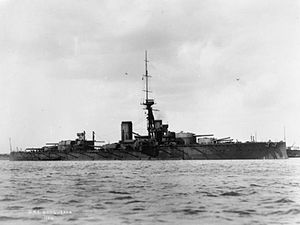 Conqueror at anchor, 1912
| |
| History | |
|---|---|
| Name | Conqueror |
| Namesake | A French ship, Conqueror, captured in 1745 |
| Builder | William Beardmore and Company, Dalmuir |
| Laid down | 5 April 1910 |
| Launched | 1 May 1911 |
| Commissioned | 23 November 1912 |
| Decommissioned | June 1922 |
| Out of service | June 1922 |
| Fate | Sold for scrap, 19 December 1922 |
| General characteristics (as built) | |
| Class and type | Orion-class dreadnought battleship |
| Displacement | 21,922 long tons (22,274 t) (normal) |
| Length | 581 ft (177.1 m) (o/a) |
| Beam | 88 ft 6 in (27.0 m) |
| Draught | 31 ft 3 in (9.5 m) |
| Installed power |
|
| Propulsion | 4 × shafts; 2 × steam turbine sets |
| Speed | 21 knots (39 km/h; 24 mph) |
| Range | 6,730 nmi (12,460 km; 7,740 mi) at 10 knots (19 km/h; 12 mph) |
| Complement | 738–1,107 (1916) |
| Armament |
|
| Armour | |
HMS Conqueror was the third of four Orion-class dreadnought battleships built for the Royal Navy in the early 1910s. She spent the bulk of her career assigned to the Home and Grand Fleets. Aside from participating in the failed attempt to intercept the German ships that had bombarded Scarborough, Hartlepool and Whitby in late 1914, the Battle of Jutland in May 1916 and the inconclusive action of 19 August, her service during World War I generally consisted of routine patrols and training in the North Sea.
After the Grand Fleet was dissolved in early 1919, Conqueror was transferred back to the Home Fleet for a few months before she was assigned to the Reserve Fleet. The ship was sold for scrap in late 1922 and subsequently broken up.